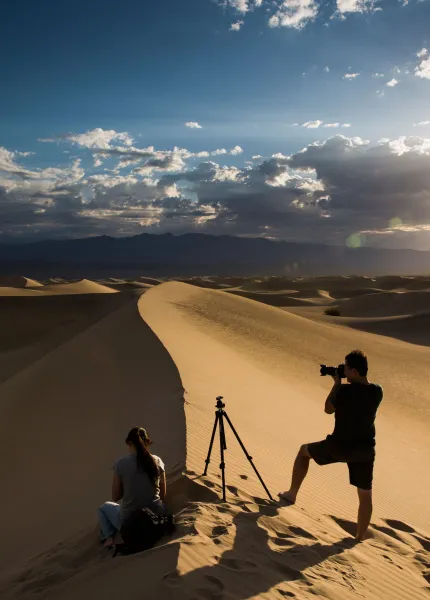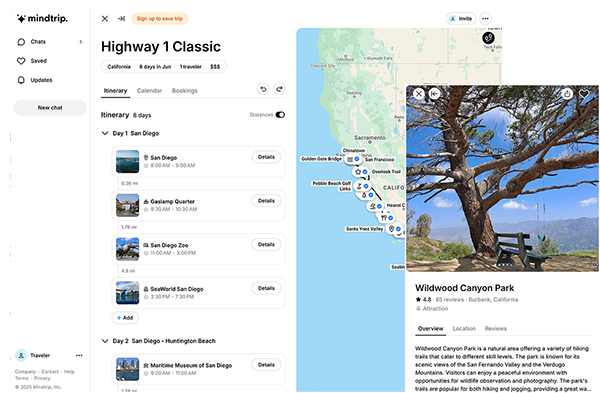Discovering Death Valley
The drive from Los Angeles to this majestic national park will leave you stunned by the massive scale, endless views, and otherworldly beauty

Trip Itinerary Overview
10 stops on this route
Stop 1
Los Angeles
Stop 2
Vasquez Rocks Natural Area Park
Stop 3
Red Rock Canyon State Park
Stop 4
Trona Pinnacles
Stop 5
Mesquite Flat Sand Dunes
Stop 6
Salt Creek Interpretive Trail
SPOTLIGHT Stop 7
Oasis at Death Valley - STAY
Stop 8
Zabriskie Point & Golden Canyon
Stop 9
Badwater Basin and Devils Golf Course
Stop 10
Furnace Creek
Car & RV Rentals
Trusted car & RV rental companies make your trip much easier
Discover More of California
Stop 1: Los Angeles
California’s largest city, Los Angeles, has nonstop action and things to do.
Start in coastal Santa Monica, with a wide beach, a lively pier topped with an amusement park, and outstanding shopping at Third Street Promenade. Legendary Beverly Hills is home to Chanel and other deluxe boutiques lining Rodeo Drive. Continue to Hollywood to stroll the Hollywood Walk of Fame and visit TCL Chinese Theatre.
Explore historic downtown Los Angeles (or simply DTLA), with attractions like the contemporary art museum The Broad and Grand Park, an urban oasis with views stretching from the Music Center (including Walt Disney Concert Hall) to City Hall.
Buildings have been transformed, including the one housing the food hall Grand Central Market, which dates back to 1917. Crowds flock to the sports and entertainment complex of Crypto.com Arena and LA LIVE, where you can also see music artifacts at the Grammy Museum and catch concerts at the Peacock Theater (the former Microsoft Theatre). Finish your trip with a visit to Universal Studios Hollywood, with movie-themed rides and backlot tours.
Planning Resources
- Discover Los Angeles – http://www.discoverlosangeles.com/
- Love Beverly Hills – http://lovebeverlyhills.com/
- Discover Los Angeles - Downtown – http://www.discoverlosangeles.com/blog/guide-weekend-getaway-downtown-los-angeles
- Downtown L.A. – https://www.downtownla.com/
Stop 2: Vasquez Rocks Natural Area Park
Even as you zip by at 65 mph along State Highway 14 near Agua Dulce, the 150-foot-tall tilted sandstone formations at Vasquez Rocks Natural Area Park might just inspire a sense of déjà vu. That’s because these distinctive, ruddy formations, uplifted by an offshoot of the San Andreas Fault to an angle of 45 degrees or more, have served as a backdrop for numerous films—everything from Blazing Saddlesto a pair of Star Trek movies. Vasquez Rocks just looks like the place where the bad guys might hang out. And indeed one did: The formations are named for the legendary California outlaw Tiburcio Vasquez.
Planning Resources
- Vasquez Rocks Natural Area Park – http://parks.lacounty.gov/vasquez-rocks-natural-area-and-nature-center/
Stop 3: Red Rock Canyon State Park
Once a popular backdrop for Hollywood westerns, Red Rock Canyon State Park protects some of Southern California’s most spectacular geology. Eroded by wind and water, the park’s multihued cliffs, buttes, and outcrops rise dramatically from the desert. Photographers gather at sunrise and sunset to capture these red and pink rocks at their most brilliant. Paleontologists flock here, too. In the cliff’s sediments are remains of prehistoric animals—three-toed horses, saber-toothed cats, and alligator lizards. The 27,000-acre park offers several short hiking trails, including into the formations of Hagen Canyon and Red Rock Canyon. Thanks to the park’s distance from city lights, nights can be spectacular, and astronomy buffs often set up telescopes here to take advantage of Red Rock’s dark skies.
Planning Resources
- Red Rock Canyon State Park – http://www.parks.ca.gov/?page_id=631
Stop 4: Trona Pinnacles
Bizarre. Surreal. Weird. Those are just a few of the reactions that visitors have when they first see the Trona Pinnacles, a cluster of 500 oddly shaped spires and towers that seem to pop up out of nowhere east of Ridgecrest. From State Highway 178, a five-mile-long dirt road (suitable for all vehicles except after rains) leads to these mineral outcrops that originally formed underwater. From a distance, the pinnacles don’t look that big but the tallest actually rises 140 feet above Searles Dry Lake. Film crews love the formations, which have appeared in vintage sci-fi flicks and more recently in a Rihanna video and the HBO series Westworld. Back on the highway after exploring the pinnacles, treat yourself to a cheeseburger and a cooling chocolate-dipped soft-serve ice cream cone at Trona’s Trails Drive In, a popular stop for Death Valley–bound travelers since 1958.
Planning Resources
- Trona Pinnacles – https://www.atlasobscura.com/places/trona-pinnacles
Stop 5: Mesquite Flat Sand Dunes
Just outside Stovepipe Wells, the Mesquite Flat Dunes are the most accessible of the five major dune systems in Death Valley National Park. Rising to a height of 100 feet, they’re far from the tallest in the park but include three different kinds of dunes. This undulating sea of sand is positively gorgeous, especially in early morning or around sunset when the light accents the dunes’ contours and wind-carved ripples. The mesquite trees that give the dunes their name also provide shelter and habitat for wildlife. Come out in the morning and you might see tracks etched in the sand by a host of nocturnal desert creatures.
Planning Resources
- Death Valley National Park – https://www.nps.gov/deva/index.htm
Stop 6: Salt Creek Interpretive Trail
Most people wouldn’t expect to see fish in Death Valley, except maybe on their plate at a restaurant. After all, the valley is the driest spot in North American and averages less than two inches of rain annually. But follow the 1-mile roundtrip Salt Creek Interpretive Trail. and from late winter into April you can watch tiny Salt Creek pupfish spawning in the shallow stream. The pupfish survive from a time when 600-foot-deep Lake Manly covered the valley floor and are one of five distinct species of pupfish found in the park.
Planning Resources
- Salt Creek - Death Valley National Park – https://www.nps.gov/deva/planyourvisit/hiking.htm#SaltCreek
Stop 7: Oasis at Death Valley - STAY
Arrive at the Oasis at Death Valley. In the resort’s more casual Ranch at Death Valley, enjoy baby-back ribs in a prickly pear barbecue sauce at the Last Kind Words Saloon.
Stop 8: Zabriskie Point & Golden Canyon
One of Death Valley National Park’s truly iconic experiences, you won’t want to miss sunrise from Zabriskie Point as the rugged badlands below the point brighten to gold with the first light of day. Trails lead down from the point and wind through the badlands, which, though stark and virtually devoid of vegetation, are absolutely beautiful. You can also explore the badlands from Badwater Road, where the short adventures include the 1-mile roundtrip to see the rock span at Natural Bridge and the 3-mile up-and-back hike through Golden Canyon to the dramatic formations at Red Cathedral.
Planning Resources
- Golden Canyon – https://www.nps.gov/deva/planyourvisit/golden-canyon.htm
- Zabriskie Point – https://www.nps.gov/places/zabriskie-point-scenic-viewpoint.htm
Stop 9: Badwater Basin and Devils Golf Course
From Furnace Creek, Badwater Road runs along the base of the mottled Amargosa Range and past the craggy, crunchy, and crystalline mineral formations of the Devils Golf Course to Badwater Basin, the lowest point in North America at 282 feet below sea level. A boardwalk leads out onto the valley’s salt flats, and, for a bit of perspective on just how low this spot is, look up from the parking area to a small sign on the cliffs. It marks the height of sea level. Another highlight of any drive on Badwater Road is to follow one-way, 9-mile Artists Drive as it meanders through colorful badlands to Artists Palette. With rock ranging in hues from green to red to violet, Artists Palette is especially beautiful when lit by the late afternoon sun.
Planning Resources
- Badwater Basin - Devil's Golf Course – https://www.nps.gov/thingstodo/visit-badwater-basin.htm
Stop 10: Furnace Creek
Furnace Creek is Death Valley’s downtown. Here you’ll find Death Valley National Park’s primary visitor center—the place to go to get oriented in this massive park that’s larger than several states. You can also take your pick of the two hotels that comprise the Oasis at Death Valley. At the more casual Ranch at Death Valley, enjoy horseback riding or golfing at the Furnace Creek Golf Course, then end your day with a whiskey and the tomahawk ribeye at the Old West–style Last Kind Words Saloon. Just down the road, the luxurious Inn at Death Valley, which debuted in 1927, recently underwent a major renovation and offers such pleasures as a spring-fed pool that perpetually remains in the mid-80s—perfect for the valley’s surprisingly chilly winter nights.
Planning Resources
- Furnace Creek area – https://www.nps.gov/tripideas/what-to-do-around-furnace-creek.htm




















